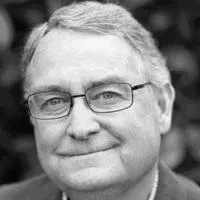

PHYSICAL HEALTH ARTICLES

The Glorious Glow of Christmas
In the early 1960s, there was always an evening in mid-December when Dad would load us in the car and drive us into a magical night. My siblings and I did not go gently into that good night. Wide-eyed and full of joy, we could not contain ourselves. The fact that Christmas was just around the corner was at the heart of it. But even more, during the course of that drive, we knew we would witness a dazzling array of lights the likes of which our little heads could hardly contain.
For me, Christmas was always synonymous with light. The further you drove up Flood Street from our southern edge of town, the brighter and more thrilling the lights became. At Merv Reber’s house on Tabernacle, we witnessed what seemed to us the most spectacular flood of white lights ever staged on this planet. As we turned onto Highway 91, now known as the Boulevard, we’d drive beneath the gloriously strung lights that canopied the street and cry out with glee as we passed under the red plastic bells that lit up, synchronistically, one-two-three, above us.
From there, we drove up Diagonal Street and then onto the Red Hill and down Hope Street, where homes were covered with lights, illuminated reindeer and sleighs, and every imaginable image of the season. As we dropped off the hill and back down into the heart of town, we turned again onto Tabernacle Street and approached the house where my dad grew up and where my grandparents still lived, and we stopped in to say hi.
Afterward, we headed home, eastward down Tabernacle Street. By the time Dad pulled the old Ford back into the carport beneath our own modest but wonderful display of lights, we were so full of light that mom must have seen us glowing through the blankets when she tucked us in our beds.
On those December night rides, Dad would tell us stories related to places along the way. But there was one story tied to the route that I did not hear for the first time until I was an adult. It was shared with me by my dear friend, Mary Phoenix, who had been my fourth grade teacher at East Elementary and my English teacher at Dixie High School. It is a story many old-timers know but one that every resident of Southern Utah should know. It is one of our community’s most sacred connections to the season.
It occurred on a cold winter’s night in a humble little adobe house at what became 294 East Tabernacle (now home of Cache Valley Bank). The year was 1869, just eight winters after the original company of Latter-day Saint settlers arrived in the St. George valley. Those who had remained were barely surviving in that desolate corner of the territory.
The town’s ecclesiastical leader, Erastus Snow, was looking for a way to lift the people out of the tedium of hunger and dreary gray days of winter. He began to plan a holiday celebration, something for the townsfolk to look forward to, something to brighten their spirits and lighten their loads. There wasn’t a lot of food, but there was plenty of musical talent in the valley, enough to stage the kind of program that might carry their spirits through to spring.
Snow called two of the town’s leading creative lights to his office: poet laureate Charles Walker and choirmaster John M. Macfarlane. The two had collaborated on a number of compositions, Walker writing the words and Macfarlane the music. Their charge was to write something special for the upcoming Christmas celebration.
Walker went right to work and composed several verses, which he passed along to Macfarlane. As the day of the event drew seriously near, John Macfarlane found himself stumped. As wonderful as Walker’s verses were, he could not put them to music.
Then one night it came to him. In the one-room adobe house on Tabernacle Street, he awoke in the darkness with not only the tune but a set of words swirling in his head. Macfarlane was a large and handsome man. His wife, Ann Chatterly, was a fine and diminutive woman, barely five feet tall and less than one hundred pounds. John rousted her out of bed and asked her to light the lamp and start pumping the bellows on the organ. The two of them, in their robes and nightcaps, shivered against the night as music permeated the chill air of their home and began to warm their hearts. John played and wrote and hummed as Ann held the lamp in one hand and pumped the bellows with the other. Not until the first rays of morning broke through the frost-glazed window did John M. Macfarlane declare it finished.
After breakfast, he hustled down Tabernacle Street to show his work to Brother Walker. Charles Walker was the first to declare its excellence. Macfarlane signed both their names to the finished copy, but Walker modestly insisted his name be removed. He later stated there wasn’t a word in the song that was his. In fact, neither man was all that concerned about taking credit. Like much of their other work, they assumed it would be performed once, then fade away.
But this song would never fade away. “Far, Far Away on Judea’s Plains” was performed to the delight of everyone at St. George’s Christmas program that year and repeated by popular demand the next year and the year after that. As Christmases came and went, the carol spread throughout the Territory, and in 1889, twenty years after it was composed in those cold night hours on Tabernacle Street, it was published in the Church of Jesus Christ of Latter-day Saints’ Juvenile Instructor magazine. By 1896, it had officially made its way into the LDS Hymn Book.
Now the song belongs to Christian people everywhere who sing its simple, profound words and heartwarming tune from the depths of their souls every Christmas. Year after year, they sing it because it expresses so perfectly their feelings for the most holy of all days.
On our family Christmas light tour each year, we always drove down Tabernacle Street and passed the very place where John and Ann Macfarlane huddled around the old bellows organ in the golden lamplight that night—the very place where a hundred years earlier, they first brought forth the strains of what would become a classic Christmas carol. It would have been a night just like those mid-December nights we rode through. And, as amazing as all those lit-up homes were, I cannot imagine their brightness coming close to eclipsing the glorious golden glow that shone in the window of that humble little adobe house at 294 East and Tabernacle.
